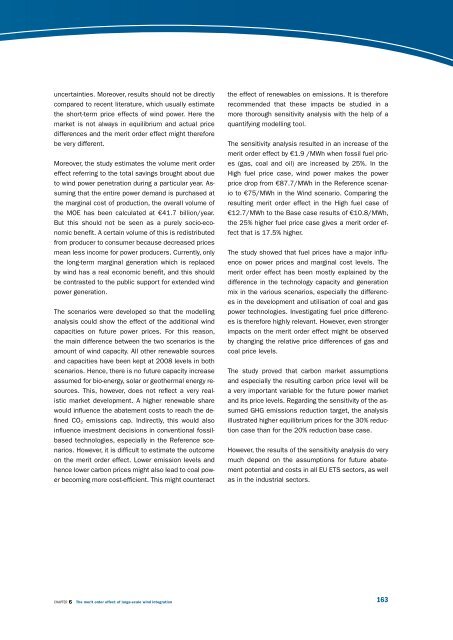Powering Europe - European Wind Energy Association
Powering Europe - European Wind Energy Association
Powering Europe - European Wind Energy Association
You also want an ePaper? Increase the reach of your titles
YUMPU automatically turns print PDFs into web optimized ePapers that Google loves.
uncertainties. Moreover, results should not be directly<br />
compared to recent literature, which usually estimate<br />
the short-term price effects of wind power. Here the<br />
market is not always in equilibrium and actual price<br />
differences and the merit order effect might therefore<br />
be very different.<br />
Moreover, the study estimates the volume merit order<br />
effect referring to the total savings brought about due<br />
to wind power penetration during a particular year. Assuming<br />
that the entire power demand is purchased at<br />
the marginal cost of production, the overall volume of<br />
the MOE has been calculated at €41.7 billion/year.<br />
But this should not be seen as a purely socio-economic<br />
benefit. A certain volume of this is redistributed<br />
from producer to consumer because decreased prices<br />
mean less income for power producers. Currently, only<br />
the long-term marginal generation which is replaced<br />
by wind has a real economic benefit, and this should<br />
be contrasted to the public support for extended wind<br />
power generation.<br />
The scenarios were developed so that the modelling<br />
analysis could show the effect of the additional wind<br />
capacities on future power prices. For this reason,<br />
the main difference between the two scenarios is the<br />
amount of wind capacity. All other renewable sources<br />
and capacities have been kept at 2008 levels in both<br />
scenarios. Hence, there is no future capacity increase<br />
assumed for bio-energy, solar or geothermal energy resources.<br />
This, however, does not reflect a very realistic<br />
market development. A higher renewable share<br />
would influence the abatement costs to reach the defined<br />
CO2 emissions cap. Indirectly, this would also<br />
influence investment decisions in conventional fossilbased<br />
technologies, especially in the Reference scenarios.<br />
However, it is difficult to estimate the outcome<br />
on the merit order effect. Lower emission levels and<br />
hence lower carbon prices might also lead to coal power<br />
becoming more cost-efficient. This might counteract<br />
chApTEr 6 themeritordereffectoflarge-scalewindintegration<br />
the effect of renewables on emissions. It is therefore<br />
recommended that these impacts be studied in a<br />
more thorough sensitivity analysis with the help of a<br />
quantifying modelling tool.<br />
The sensitivity analysis resulted in an increase of the<br />
merit order effect by €1.9 /MWh when fossil fuel prices<br />
(gas, coal and oil) are increased by 25%. In the<br />
High fuel price case, wind power makes the power<br />
price drop from €87.7/MWh in the Reference scenario<br />
to €75/MWh in the <strong>Wind</strong> scenario. Comparing the<br />
resulting merit order effect in the High fuel case of<br />
€12.7/MWh to the Base case results of €10.8/MWh,<br />
the 25% higher fuel price case gives a merit order effect<br />
that is 17.5% higher.<br />
The study showed that fuel prices have a major influence<br />
on power prices and marginal cost levels. The<br />
merit order effect has been mostly explained by the<br />
difference in the technology capacity and generation<br />
mix in the various scenarios, especially the differences<br />
in the development and utilisation of coal and gas<br />
power technologies. Investigating fuel price differences<br />
is therefore highly relevant. However, even stronger<br />
impacts on the merit order effect might be observed<br />
by changing the relative price differences of gas and<br />
coal price levels.<br />
The study proved that carbon market assumptions<br />
and especially the resulting carbon price level will be<br />
a very important variable for the future power market<br />
and its price levels. Regarding the sensitivity of the assumed<br />
GHG emissions reduction target, the analysis<br />
illustrated higher equilibrium prices for the 30% reduction<br />
case than for the 20% reduction base case.<br />
However, the results of the sensitivity analysis do very<br />
much depend on the assumptions for future abatement<br />
potential and costs in all EU ETS sectors, as well<br />
as in the industrial sectors.<br />
163

















